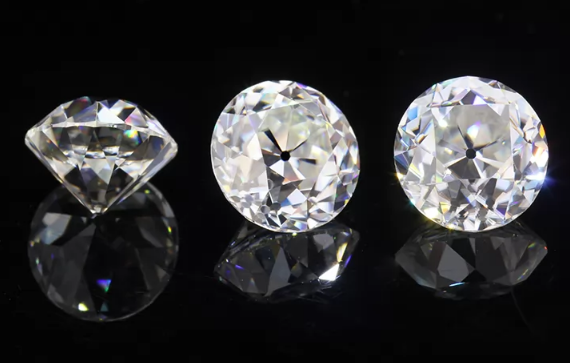Are you inclined to wear a vintage engagement ring with a rich history? Old European cut diamonds were the predominant cut from the Victorian era through the Art Deco period of the 1920s. Round in shape and crafted to sparkle, this style eventually evolved into the modern round brilliant cut that remains popular today.
What are Old European Cut Moissanite?
You may recognize a vintage ring when you see one, but what exactly is an Old European Cut moissanite? Also known as an Old English Cut moissanite, this diamond-cutting technique originated in Europe during the late 1800s. Prior to modern technology, diamond cutters relied on manual labor to meticulously fashion round, multi-faceted moissanite from rough stones.
The Old European Cut quickly gained popularity and paved the way for the development of the modern brilliant cut. Today, advancements in technology allow for precision and measurability in the creation of diamond cuts, including the Old European Cut.
Both styles feature a round shape and numerous tiny facets designed to reflect light and enhance sparkle. However, it's important to note that Old European Cut moissanite tend to exhibit more imperfections since they were hand-cut. Their facets are bigger and not as precise, and they sparkle differently too. Back then, diamond cutters cut stones to make them sparkle under candlelight and gas lamps. A European cut moissanite shines with bright flashes instead of the overall sparkly brilliance of modern diamonds.

How to Identify an Old European Cut Diamond?
The most apparent feature to look for when identifying an Old European Cut diamond is the visible culet. This pronounced culet, visible when viewing the stone from the top, is a hallmark of these diamonds. In fact, the culet can be observed on diamonds over 1 carat without the aid of a loupe.
In addition to the culet, there are several other methods for identifying an Old European Cut diamond. One such characteristic is a small table, which refers to the diamond's top facet. Another distinguishing feature is a glazed and opaque girdle that encircles the diamond between the crown and pavilion. This type of girdle is commonly associated with older diamonds.
Furthermore, small side cracks in the girdle indicate the diamond's age. The larger facets, which appear "less splintered" compared to modern brilliant-cut diamonds, are another distinguishing trait. These unique characteristics set an Old European Cut diamond apart from its contemporary counterparts, such as round brilliant-cut diamonds.
Lastly, it's important to differentiate between the Old European Cut and the Old Mine Cut diamond, an earlier version of the round brilliant-cut diamond. The Old European Cut is round with a higher crown, a smaller table, and a larger culet, whereas the Old Mine Cut is more square-shaped with a higher crown, a smaller table, and larger facets. Recognizing these subtle distinctions as a jewelry expert is both challenging and rewarding.
Are Brilliant Cut Diamonds Better than Old European Cut Diamonds?
Today's brilliant cut round diamonds strictly adhere to the 4Cs - color, cut, clarity, and carat weight. With 58 precisely cut facets, these diamonds are engineered to maximize brilliance.
Beyond the 4Cs: Understanding Other Diamond Characteristics
However, that doesn't necessarily make them superior for everyone. There's a certain charm in the imperfect perfection of old European cuts. Each diamond, with its hand-cut character, possesses a unique appeal.
Another advantage of old European cuts is their ethical aspect. Opting for antique rings ensures an environmentally conscious choice, as the metals and stones are essentially recycled into something new and unique for the buyer.
Old European Cut Diamond | Modern Round Brilliant Diamond cut |
Round shape but naturally imperfect | Perfectly round shape |
Larger hand-cut facets | Small precise facets |
Firey candlelit glow | High sparkle and brilliance |
Ethically sourced since they’re “recycled” antiques | Can be ethically sourced but aren’t always |
Who Should Wear an Old European Cut Diamond Ring?
If you have an appreciation for antiques or vintage styles, then old European cut diamond engagement rings are perfect for you. You'll discover stunning Art Deco or Victorian settings that have stood the test of time.



 Lab Grown Emerald
Lab Grown Emerald


